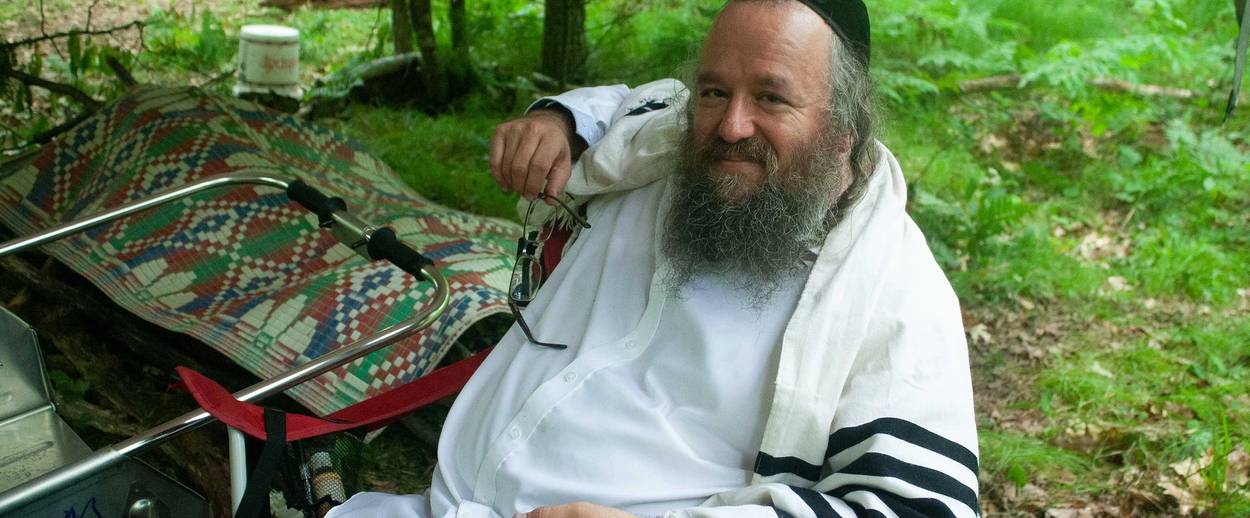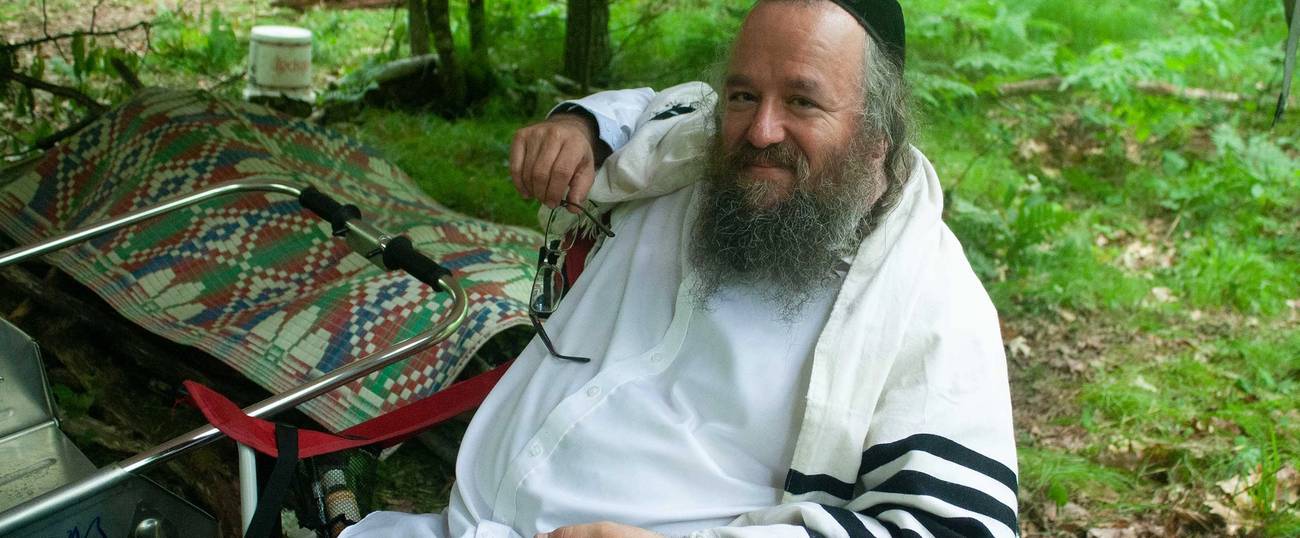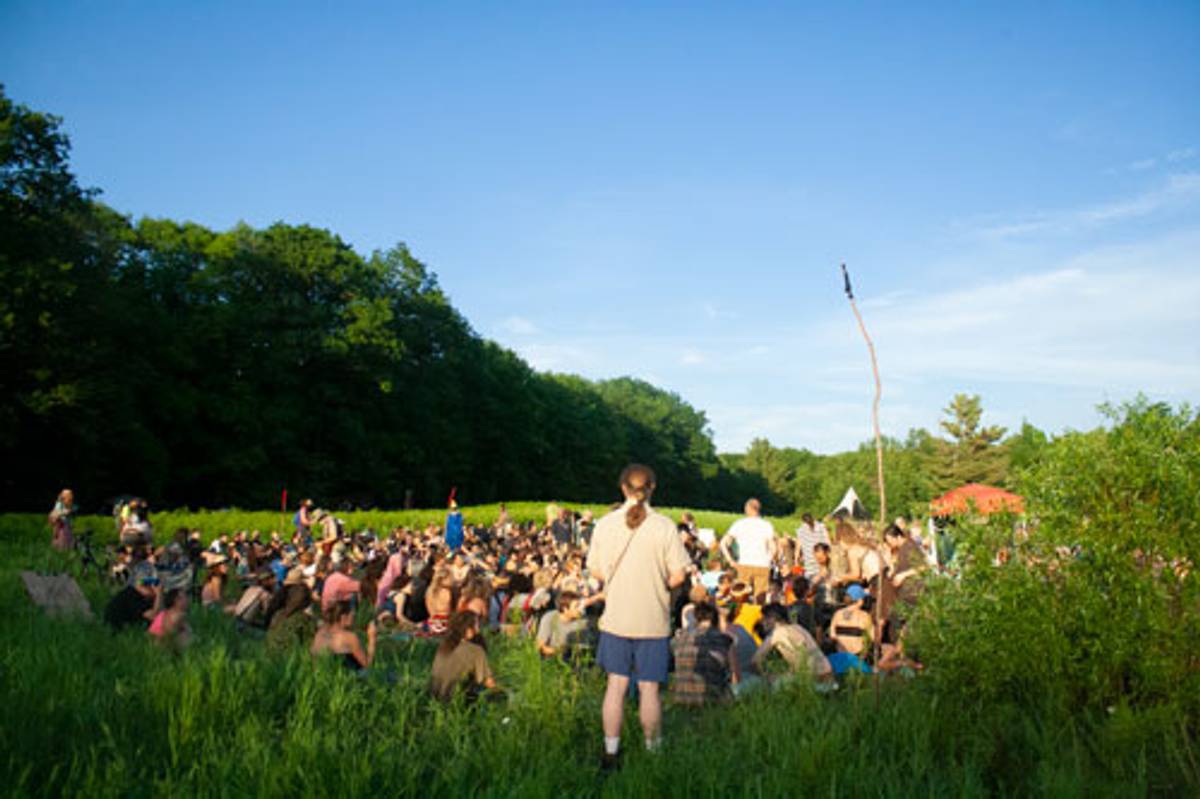The Rainbow Connection
Finding Jewish family in a Wisconsin forest, at the annual Rainbow Gathering




I went to my first Rainbow Gathering last month in search of a kind of Judaism I clicked with—something at once holy and hippie, frum yet free, all-encompassing and accessible to anyone of any religious or spiritual background.
The steadfast counterculture of Rainbow can feel a bit like a time capsule, the closest you’ll get to an era now half a century in the past. Every year, thousands of the Rainbow “family”—including a significant Jewish contingent—make the pilgrimage to a remote national forest to camp, cook, sing songs, and collectively pray for world peace. Even though I’d never been to a gathering before, I knew vaguely what I was in for during my five days deep in the woods of Wisconsin: maybe some Carlebach tunes around a campfire, dreadlocked white guys, magic mushrooms, nomadic punks (and their dogs), nudists, and Rainbow catchphrases (“loving you”) that I’d heard around Brooklyn and upstate New York from Rainbow family I met at other festivals.
What I didn’t expect, when I got to Rainbow, were the hippie children, as free and natural as children should be, playing among the dragonflies and tall grass in the open meadow; the nightly communal dinner that reminded me of mealtime at my Berkeley student co-op, where simply feeding one another was an act of love; a drum circle around a fire that went from sundown to sunrise; and a kind of back-to-the-land Judaism that felt like an expression of biblical values applied to contemporary life.
Indeed, Rainbow was a trip unto itself, a realization of psychedelic ethos—peace, love, and unity—put into practice.
*
The Rainbow Gatherings began officially in 1972. Since then, the Rainbow Family of Living Light has congregated every summer in a different forest to live peacefully for a week, or several, in a noncommercial, nonhierarchical hippie utopia. There are no leaders, no exchange of money, and no trace left behind once the gathering finally dissembles (though it takes at least a month to fully clean up the forest). Everyone is responsible for manifesting the vision.
While often compared to Burning Man, Rainbow is rootsier, nonticketed (read: free), and lacking the fanfare surrounding Burning Man’s elaborate camps, big-name DJs, and large-scale art installations. Simply put, it’s more authentic: Unlike the Burn, which draws Silicon Valley elites and others who use that week in the desert as a cathartic escape from regular life, Rainbow is for many a lifestyle unto itself.
At its peak in the 1980s, Rainbow drew around 35,000 people. This year, about 4,000 gathered in Wisconsin’s Chequamegon-Nicolet National Forest. Family—those who participate in the gathering—greeted my traveling companions and me with the catchphrase “welcome home” (to which we replied, “welcome home”) as we schlepped our bags more than a mile from our parking spot on a dusty road outside the forest to our campground.

On our way, we met an old man called Baba-ji, with a walking stick and a white sarong, who escorted us through the gathering. We passed several camps spread throughout the woods, such as Loven Ovens (they bake bread daily), Krishna Kitchen (they chant Hare Krishna all day), Kiddie Village (where most of the families camped), Jesus Kitchen (wholesome Christians), Heart Fire Cafe (good food, good people), and even a 12-Step camp called Serenitea. Then we arrived at Home Shalom, the Jewish camp, where we’d be staying—with about 15 other people, camping in tents spread out around a main trail through the Gathering. Home Shalom also had a central tarp, a fire pit, folding chairs, and the largest of all tents containing several weeks’ worth of food. A few days after we got there, a few campers would build a countertop for food out of chopped wood and rope.
Since its inception, Rainbow has always had a Jewish flavor, and since 1979, there have been various iterations of the Jewish camp: Twelve Tribes and Jerusalem Camp, to name a couple, and now Home Shalom. In fact, the original map of the gathering “turned out to be virtually the same as the map of the wandering Hebrew tribes camped in the wilderness,” explained Garrick Beck, a Jewish “OG” (original gatherer), who said he had verified this information with folks at 770 Eastern Parkway, the Chabad-Lubavitch World Headquarters.
During the initial years of the gathering, the OGs were more interested in fostering unity, rather than focusing on where each of them was coming from, said Beck, who himself hails from the Upper West Side and now owns a gem and mineral shop in Santa Fe. But as the gathering grew, the camps and kitchens evolved to reflect the family’s diverse heritage. “[These heritages] also became sources of wisdom that we were drawing on to build a new world in the shell of the old world,” he told me.
One of the first iterations of the Jewish camp, Beck said, was founded by two brothers from Boston, both rabbis, “who had held a psychedelic Seder in Eugene, Oregon, [and] sang a lot like Shlomo [Carlebach].” While an “enormous number” of Rainbow family were born Jews, and some were trying to escape it, he added, “most are really glad that the Jewish faith has become an eternal part of Rainbow.”
The Jewish camp, in all its manifestations, has had a good influence on the gathering, Beck continued: “It has given people a place where they can reconnect with their roots and, at the same time, maintain their relationship with the much larger world family.” And by each camp sharing their songs, recipes, and legends, he said, “we learn they’re not so different from us.”
As for Home Shalom, the main event is Shabbat—featuring a Kabbalat service, an eruv, and enough food to serve 100 plates with challah and kugel freshly baked over a campfire in a Dutch oven.
For decades, Shabbat has been what the Jewish camp is known for throughout the gathering, once luring up to 2,000 people (including unaffiliated Jews who come out of the woodwork) for Friday night dinner.
Part of the impetus behind having a Jewish camp is to make a kiddush HaShem—a positive Jewish impression on the outside world—said Shmuel Leaderman, a Home Shalom “focalizer” from Los Angeles, who told me he’s met a number of people from activist communities like Rainbow or Occupy who have never met a Jew before. “It’s very important that the Jewish camp make a good show,” he said, “that they see we’re out here doing good things, and that Judaism is noble and teaches good ethics.”
It’s a learning experience for both Jews and gentiles. Coming from an Orthodox background, Leaderman said that Rainbow taught him to grapple with people or circumstances, within the Jewish camp and outside it, that he initially struggled with. “I became a lot more self-aware of how to talk to people, communicate, and manage situations,” he said. But cooperation and acceptance is only a piece of the puzzle: Rainbow provides a sense of collective spirituality, as well.
The climax of Rainbow Gathering is the communal prayer for world peace on the Fourth of July. The silent circle of several thousand joining hands had already om’ed in unison and broken out into ecstatic frenzy by the time I ventured out of Home Shalom, through the woods and down the hill toward the main meadow.

“It was beautiful and inspiring all at the same time to be part of a universal ceremony for peace,” Avi Newman, a Chicago-based software engineer from Kiddie Village, said of the July 4th communal prayer. As it ended, a camper from Home Shalom approached him with tefillin. “I said a lightning shacharit—the shortest morning prayer of my life—and yet it was also the most intense and joyous prayer experience I can recall,” said Newman. “The words of my ancestors flowed as if they were an inertial continuation of the Rainbow circle that had just manifested. I’m no longer an observant Jew and my own tefillin will likely continue to sit in a drawer for another 22 years, but I was inspired by Rainbow to pray with universality going forward, even if the words come out of me in Hebrew.”
To Moshe Geller, a Deadhead who ran Jerusalem Camp from the late-’90s through the mid-aughts, the reason behind Rainbow’s substantial Jewish presence is simple: “In a place of spiritual seeking, Yidn are going to be there.” A legend in the gathering’s Jewish history, Geller was once dubbed “the Rainbow rabbi”—a title that “freaked” him out: “It’s not about me,” he said, “it’s about them becoming who HaShem dreams for them to be, Jewish or not.”
For many, Rainbow is a jumping-off point to dive deeper into oneself. And for a handful, psychedelics play no small role in that self-discovery. “They make you more you,” said Hasidish psychonaut Mordechai Carr, who uses psychedelics to commune with God. (He even had his first meeting with his rebbe on acid.)
“It’s all about a journey of self-love, to truly accept myself because I’m OK exactly as I am,” said Brooklyn-based musician Ezzy Gluck. “I had a very strict, Hasidish upbringing. But here, I get to just be naturally who I am, in my weirdness, my awkwardness, my adventurousness. Coming to Rainbow allowed me for the first time to shine, and I found it therefore to be extremely healing.”
The phenomenon of Haredim who foray into the secular, countercultural world is niche, although predictable. There’s a familiarity between the counterculture of Rainbow and the counterculture of the Haredi world, explained Shaul Magid, a professor of Jewish studies at Dartmouth College. “Both countercultural movements are focused on a kind of ecstatic experience,” he said. “In a way, Rainbow is the perfect opportunity for them because it’s total anonymity; nobody will recognize them because nobody from their world goes.” It makes sense, Magid said: “They’re looking to have an enhanced religious experience,” and without the stigma around cannabis or psychedelics that’s present in the secular world, Haredim are perfectly primed to reap the benefits of Rainbow without compromising their observance.
After all, what with hitbodedut (Jewish meditation in nature) and a history of wandering the desert, “Judaism has a deep connection to the woods and the wilderness,” Leaderman pointed out.
That relationship to nature inspires a Rainbow lifestyle back home after the gathering. “It empowers people to create and collaborate,” said Tsiporah Gottesman, a Brooklyn-based “focalizer” behind Home Shalom. While city life is so abundant, she said, Rainbow is grounding and challenging, with valuable takeaways about “creating within the limitations of nature.”
At the same time, Gottesman said, wherever there’s a community like Rainbow doing peace work, Jews need to be there. “I’m talking about just showing up and having those conversations about the police, about food, about our water,” she said. “I don’t think that Jews only need to have political conversations when we’re talking about Jews. It’s important to contribute on the same level as everyone in these conversations—just because we’re all humans and we’re all doing the same thing.”
*
I went to Rainbow seeking a Jewish experience, but simultaneously and perhaps more significantly, I had a human experience. I pooped in the woods. I bathed in a lake. I shared food with strangers, who Rainbow had me consider family.
For me, the gathering was an exercise in navigating unstructured time—without cell service or Wi-Fi—forcing me to adopt the practice of “be here now.” I’d spend my days wandering about the open meadow or the woods, visiting other camps, chanting some Hare Krishna, and drumming on upside down buckets at Home Shalom while others strummed on their guitars, singing niggunim. Every evening before sundown, I’d bring my metal bowl and fork-spoon-combo to the main meadow, take a spot cross-legged in a circle among other gatherers, and wait for cooks from each camp, who would congregate in center circle, to make their way to me, plopping spoonfuls of lentils or soup or rice into my bowl. And at night, I’d kick off my shoes and hula hoop by the drum circle. Other camps would host campfire jam sessions or improv theater.
I spent all day on Friday chopping garlic and onions for our Shabbos kugel, before I fumbled over trying to fold dough into the shape of challah. Others chopped wood to make a countertop, and still others prepared how they would lead the kabbalat service. I realized being there, Rainbow isn’t a place to go and consume the culture. It’s a place to make the culture, adhering to the gathering’s ideology of freedom, harmony, sustainability, and community. To eat the camp’s food, to pitch your tent around the camp, to be family—Jewish or otherwise—is to participate and make for yourself the experience you’re looking to have.
***
Like this article? Sign up for our Daily Digest to get Tablet magazine’s new content in your inbox each morning.
Madison Margolin is a journalist living in New York. She specializes in writing about Jewish culture and drug policy.